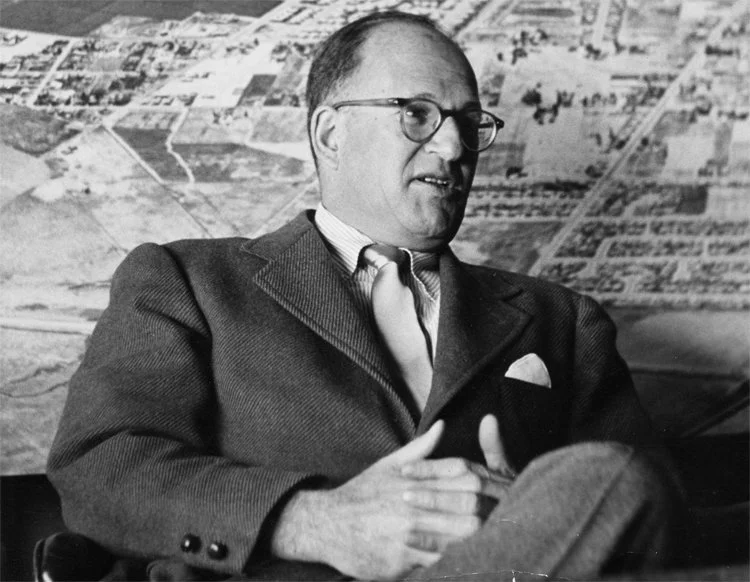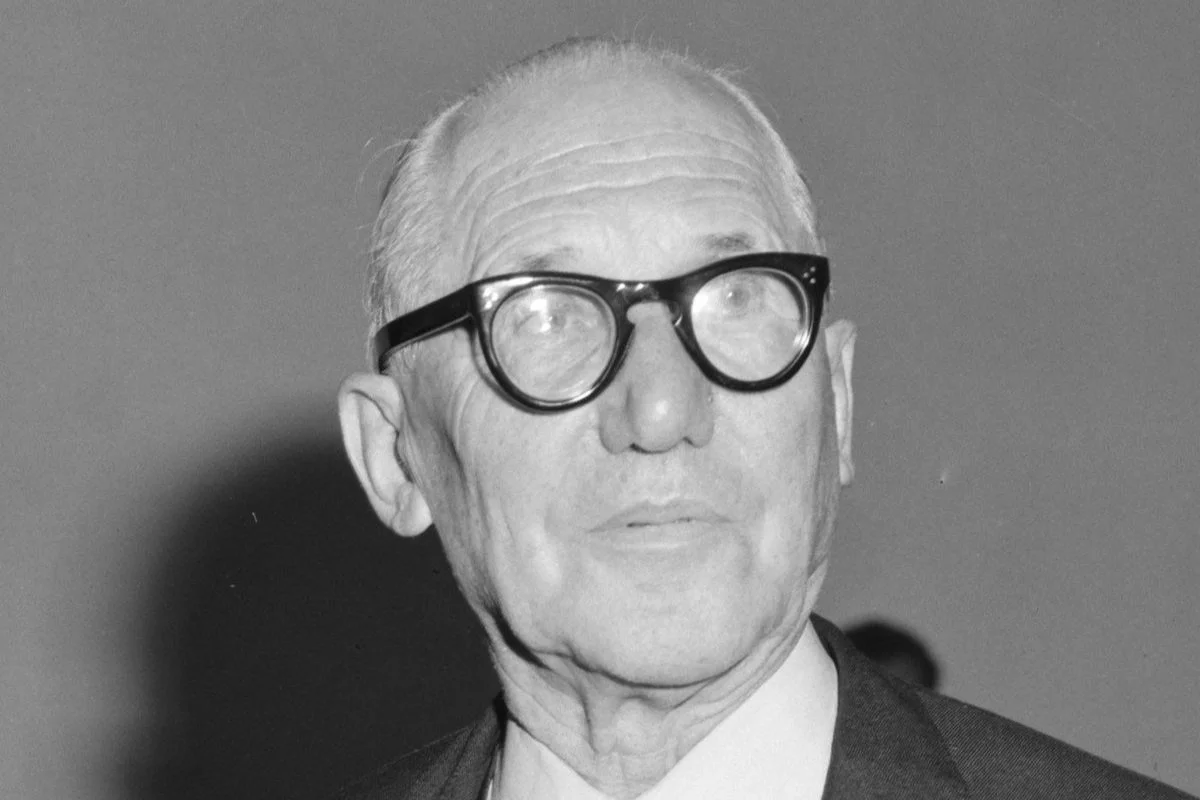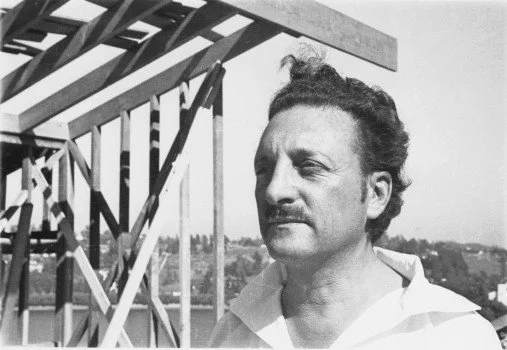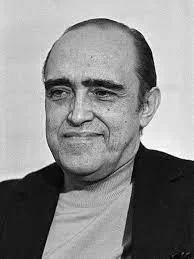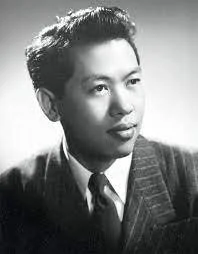Famous Mid-Century Modern Architects
Mid-Century modern architecture, an influential style that emerged in the mid-20th century, was inspired by the post-World War II era's innovative spirit and exploration of new materials. Renowned architects of this period designed groundbreaking structures characterized by clean lines, indoor-outdoor living, and wood material. This style emphasized simplicity, functionality, and a seamless integration with the natural environment.
Here is a list of some of the most celebrated mid-century modern architects whose visionary work continues to inspire and shape contemporary design.
A. Quincy Jones
Left: A. Quincy Jones, Middle: Joseph Eichler, Right: Frederick Emmons
A. Quincy Jones’s influence on Los Angeles architecture is profound. As a designer and educator, his work, including the Warner Bros. Records headquarters, showcases his innovative spirit and commitment to functional, beautiful design.
After being discharged from the Navy in 1945, A. Quincy Jones returned to Los Angeles, opened an architectural office, and quickly secured his first client. Partnering with Paul R. Williams, he worked on notable Palm Springs projects and participated in the Case Study House program. The 1950 issue of Architectural Forum highlighted Jones's work, leading to a collaboration with Joseph Eichler, which allowed Jones to pioneer the integration of greenbelts in moderate-income housing. In 1960, Jones helped develop Irvine, California, furthering his greenbelt concepts. His partnership with Frederick Emmons, from 1951 to 1969, resulted in designing about 5,000 Eichler homes and earned them the AIA Firm of the Year award in 1969.
Ashen and Allen
Standing: Robert ‘Bob’ Anshen, Sitting: William Stephan Allen
Anshen and Allen, founded in San Francisco in 1940 by Samuel Robert "Bob" Anshen and William Stephen "Steve" Allen Jr., grew into an influential international architecture, planning, and design firm. Initially known for projects like the Davies House in Woodside, California, the firm diversified into gas station prototypes, parking garages, and residential developments such as Eichler and Mackay Homes in the California Modernist style during the 1950s and 1960s. Under Derek Parker's leadership in the late 1970s and early 1980s, Anshen and Allen expanded into a modern global practice, embracing technologies like Building Information Modeling (BIM) and pioneering Integrated Project Delivery methods. Recognized for sustainable practices, particularly in healthcare and academic markets, the firm was acquired by Stantec in 2010, marking a new phase in its storied history.
Claude Oakland
Left: Claude Oakland, Right: Joseph Eichler
Claude Oakland, born in Louisiana in 1919, emerged as a pivotal figure in American residential architecture through his association with Joseph Eichler and the development of Eichler Homes. Joining Anshen & Allen in 1950, Oakland quickly became the principal designer for Eichler Homes, Inc., a position he held until founding his own firm, Claude Oakland & Associates, in 1960. His collaboration with Eichler spanned over two decades, during which Oakland's designs epitomized the mid-century modern aesthetic characterized by open floor plans, integration with nature through atriums and large glass facades, and a focus on functionality and innovation. Oakland's legacy is deeply intertwined with Eichler's vision, having contributed to the creation of over 3,000 residences that not only defined the Eichler style but also evolved it to meet the changing needs of modern families while maintaining its architectural integrity.
Charles and Ray Eames
Charles Eames and Ray Eames, renowned as a creative powerhouse and a married couple in American design history, left an indelible mark on modern architecture, furniture, and beyond through their prolific work at the Eames Office. Beginning with their groundbreaking experiments in molded plywood during World War II, the Eameses' innovative approach merged artistry with functionality, epitomized by iconic designs like the Eames Lounge Chair and their contributions to industrial and graphic design. Their partnership extended into filmmaking, where they explored educational and artistic themes, exemplified by the influential "Powers of Ten." Their holistic design philosophy also encompassed architecture, notably seen in their own residence, the Eames House, a landmark of mid-century modernism in Pacific Palisades. Charles and Ray Eames's collaborative ethos and commitment to craftsmanship continue to resonate across disciplines, shaping contemporary design practices and inspiring generations of designers worldwide.
Charlotte Perriand
Charlotte Perriand, born in 1903 in Paris, was a pioneering French architect and designer known for her influential contributions to modernism and functional living spaces. Educated at the Central Union of Decorative Arts, she gained early recognition for her innovative furniture designs exhibited at the 1925 Exposition Internationale des Arts Décoratifs et Industriels Modernes. Perriand's career was notably shaped by her collaboration with Le Corbusier, where she played a pivotal role in interior design and furniture development from 1927 to 1937. She later broadened her focus to include populist and egalitarian design principles, using traditional materials and advocating for affordable housing solutions. Her post-World War II experiences in Japan and Vietnam further enriched her approach, integrating Eastern influences into her work. Perriand's legacy includes iconic designs like the LC2 Grand Confort chair and her visionary contributions to ski resort architecture at Les Arcs, emphasizing efficiency and harmonious integration with nature. She passed away in 1999, leaving a lasting impact on modern design and architectural philosophy.
Pierre Koenig
Pierre Francis Koenig was an influential American architect and Professor of Architecture at the University of Southern California (USC). Born in San Francisco in 1925 and relocating to Southern California in 1939, he served in World War II before earning his Bachelor of Architecture from USC in 1952. Koenig's career is notable for his contributions to the Case Study House program, particularly Houses No. 21 (Bailey House) and No. 22 (Stahl House), which are celebrated for their innovative designs and dramatic locations. House No. 22, with its iconic photograph by Julius Shulman, epitomizes postwar L.A. architecture. Koenig's impact on architecture extended through his 40-year teaching career at USC, where he directed the undergraduate building science program and the Natural Forces Laboratory.
Koenig's architectural legacy is marked by numerous awards, including the USC Distinguished Alumni Award and the Gold Medal from the Los Angeles chapter of the American Institute of Architects. His work was extensively recognized in James Steele's 1998 book "Pierre Koenig." Elevated to "Distinguished Professor" at USC after 35 years, Koenig was known for his innovative use of materials and his emphasis on sustainable design. He passed away from leukemia in 2004 at the age of 78, survived by his wife Gloria, sons Randall and Jean Pierre, and stepsons Barry and Thomas Kaufman. His designs continue to be celebrated, with Case Study House #21 selling for $3.1 million in 2007, and his Brentwood residence, restored by his stepsons, listed for $3.8 million in 2017.
Le Corbusier
Le Corbusier, born Charles-Édouard Jeanneret-Gris in 1887, was a pioneering Swiss-French architect and urban planner who profoundly influenced modern architecture. His career spanned from the early 20th century to his death in 1965, leaving an indelible mark on architectural theory and practice. Known for his belief in functionalism and geometric clarity, Le Corbusier's work ranged from individual homes like the Villa Savoye and the iconic Unité d'Habitation in Marseille, to urban planning projects like Chandigarh in India. He was a key figure in the International Style movement, advocating for simplicity, functionality, and the use of new materials like reinforced concrete. His influence extended globally, shaping the development of cities and architectural education well beyond his lifetime.
Ludwig Mies van der Rohe
Ludwig Mies van der Rohe, born in Germany in 1886, became one of the most influential architects of the 20th century, epitomizing the International Style with his elegant simplicity and rectilinear forms. Lacking formal architectural training, Mies honed his skills through practical experience, assisting his father, a master mason, and working with several architects in Aachen and Berlin. His early work included an apprenticeship with furniture designer Bruno Paul and a significant stint in Peter Behrens' office, where he connected with other future architectural luminaries like Walter Gropius and Le Corbusier. Behrens introduced Mies to the Deutscher Werkbund, an association advocating the integration of art and technology, which profoundly influenced Mies’s design philosophy.
Eileen Gray
Eileen Gray, a pioneering Irish architect and furniture designer born in 1878, emerged as a central figure in the Modern Movement of the early 20th century. Despite lacking formal architectural training, Gray's creative journey began with fine arts education in London and Paris, where she developed a fascination for lacquer work and furniture design. Her career blossomed in the 1920s with the opening of her Parisian shop, Jean Désert, which showcased her innovative designs blending luxurious materials with geometric simplicity.
Gray's architectural masterpiece, E-1027, built in collaboration with Jean Badovici, exemplifies her design ethos of functional elegance and spatial harmony. Situated in Roquebrune-Cap-Martin, France, E-1027 is celebrated for its cubist-inspired form and integrated furniture designs, such as the iconic Bibendum Chair and the Pirogue Day Bed. Gray's contributions to architecture and design continue to inspire, reflecting her belief in creating spaces that seamlessly marry form and function while embracing modernist principles ahead of her time.
John Lautner
John Lautner (1911-1994) was an influential American architect known for his innovative and organic approach to residential design, primarily based in California. Initially apprenticed under Frank Lloyd Wright, Lautner developed a distinctive style that integrated geometric forms with natural surroundings, creating homes that often defied traditional architectural norms. His work spans over 200 projects, emphasizing open-plan layouts, inventive use of materials like concrete and steel, and a strong connection between indoor and outdoor spaces. Lautner's notable designs include the iconic Chemosphere House, which exemplifies his mastery of futuristic, cantilevered structures. His architectural legacy extends beyond individual buildings to a broader impact on modernist architecture in California and beyond, influencing subsequent generations with his bold, forward-thinking designs.
Richard Neutra
Richard Joseph Neutra, an Austrian-American architect, left an indelible mark on modernist architecture through his innovative designs and meticulous attention to client needs. Born in Vienna in 1892, Neutra's career spanned continents, with notable contributions in Southern California where he crafted geometrically precise, yet airy structures that epitomized mid-century modernism. His influential works include the Lovell Health House (1929), the VDL Research House (1966), and the iconic Kaufmann Desert House in Palm Springs. Neutra's approach to architecture, which emphasized functional, adaptable spaces integrated harmoniously with their surroundings, continues to inspire architects and urban planners globally. His legacy, marked by honors like the AIA Gold Medal and a Golden Palm Star, underscores his lasting impact on the built environment and design philosophy.
Luis Barragán
Luis Ramiro Barragán Morfín, a seminal figure in Mexican architecture, revolutionized modernist design with his distinctive blend of color, light, and spatial harmony. Born in Guadalajara in 1902, Barragán initially trained as an engineer before immersing himself in architecture, later traveling extensively through Europe where he encountered influential figures like Le Corbusier. His architectural philosophy emphasized an "emotional architecture" that transcended mere functionality, focusing instead on creating serene, contemplative spaces infused with raw materials like stone and wood. Barragán's notable works include the Torres de Satélite, an urban sculpture in collaboration with Mathias Goeritz, and his own house and studio in Mexico City, now a UNESCO World Heritage Site. Awarded the prestigious Pritzker Prize in 1980, Barragán's legacy continues to inspire architects worldwide, influencing contemporary minimalism and landscape design with his profound understanding of space and light. His enduring impact is celebrated through institutions like the Barragán Foundation, which preserves his archives and promotes his cultural legacy globally.
Greta Magnusson Grossman
Greta Magnusson-Grossman, born in 1906 in Sweden, was a pioneering figure in mid-20th century modern design, known for her contributions to furniture design, interior design, and architecture. Trained initially in furniture design at Konstfack in Stockholm and later in architecture, she won acclaim early in her career, becoming the first woman to receive the Furniture Design award from the Swedish Society of Industrial Design in 1933. In 1940, she moved to Los Angeles with her husband, where they established a successful studio specializing in furniture and lighting. Her work combined European modernist influences with the lifestyle of Southern California, attracting notable clients like Greta Garbo and Ingrid Bergman. Grossman's architectural designs, characterized by open plans and innovative use of materials, contributed significantly to the Los Angeles modernist scene. Despite living in relative obscurity for the latter part of her life, her legacy has been recognized through retrospectives and auctions of her iconic designs, which continue to influence contemporary design practices.
Arne Jacobsen
Arne Jacobsen, born in 1902 in Copenhagen, was a seminal figure in 20th-century architecture and furniture design, known for his contributions to functionalism and modernism. Trained at the Royal Danish Academy of Fine Arts, Jacobsen's early exposure to international styles like Art Deco and Bauhaus profoundly influenced his aesthetic. His career took off with projects like the Bellevue Sea Bath and the SAS Royal Hotel, where he applied his signature minimalist style and meticulous attention to detail. Jacobsen's furniture designs, such as the Ant chair, Egg chair, and Swan chair, became iconic for their blend of form and function, often designed in tandem with his architectural commissions. His work continues to be celebrated for its elegant proportions and enduring influence on Scandinavian design and modern architecture globally.
Lina Bo Bardi
Lina Bo Bardi, an Italian-born Brazilian architect and designer, played a pivotal role in 20th-century modernism with her innovative and socially conscious approach to architecture. After earning her degree in architecture from the University of Rome, she moved to Brazil in 1946 with her husband Pietro Maria Bardi. There, she made significant contributions to Brazilian design and culture, most notably through her work on the Museum of Art of São Paulo (MASP) and the iconic Glass House in São Paulo. Bo Bardi's designs merged Modernist principles with local materials and vernacular styles, reflecting her commitment to what she termed "Arquitetura Povera" or simple architecture. Her career spanned diverse projects from furniture design to preservation efforts, leaving a lasting legacy as one of the most influential women architects of her time.
Eero Saarinen
Eero Saarinen, a Finnish-born American architect, was a pivotal figure in mid-20th century architectural innovation and experimentation in the United States. Son of renowned architect Eliel Saarinen, Eero's career began with significant projects like the General Motors Technical Center, marked by his meticulous attention to integrating form with function. His designs departed from the austerity of the International Style, introducing sculptural and expressive elements that defined his distinctive style. From the iconic TWA terminal at JFK International Airport to the graceful Gateway Arch in St. Louis, Saarinen's works embodied a blend of structural ingenuity and visual impact, setting new standards in modern architecture. His furniture designs, including the iconic Tulip chairs and tables, paralleled his architectural innovations, further cementing his legacy as a visionary designer. Despite his premature death in 1961, Saarinen's influence on architecture remains profound, characterized by his commitment to pushing the boundaries of architectural expression and functionality.
Walter Gropius
Walter Gropius, a pioneering German-American architect and educator, profoundly influenced modern architecture through his leadership at the Bauhaus and his subsequent career. Born in Berlin in 1883, Gropius initially trained under Peter Behrens, where he developed a passion for integrating art with industry. As director of the Bauhaus from 1919 to 1928, he transformed design education, emphasizing practical crafts alongside artistic expression, and promoting a rational, functional approach to architecture. His iconic Bauhaus building in Dessau exemplifies his belief in the International Style—marked by asymmetry, simplicity, and industrial materials. Forced to leave Germany during Nazi rule, Gropius continued his influence at Harvard, where he introduced Bauhaus principles and co-founded The Architects Collaborative (TAC). His legacy lies in his advocacy for modern design's social relevance and his role in shaping architectural education worldwide.
Rudolph M. Schindler
Rudolph Schindler, an Austrian-born American architect, emerged as a maverick within the modernist movement of the early 20th century, particularly noted for his innovative designs in and around Los Angeles. Born in 1887 in Vienna, he initially trained under influential figures like Otto Wagner and Adolf Loos before being captivated by Frank Lloyd Wright's work. Schindler's career took him from Vienna to Chicago, where he worked briefly with Wright, and eventually to Los Angeles, where he established his distinctive style characterized by complex, three-dimensional forms and the innovative use of materials like concrete and plaster. His notable works include the Kings Road House (1922), Lovell Beach House, and the Rodriguez House, each reflecting his commitment to integrating architecture with its natural surroundings and achieving functional beauty within strict budgets. Despite initial obscurity, Schindler's designs are now recognized for their forward-thinking approach and are experiencing renewed appreciation among contemporary architects and scholars.
Oscar Niemeyer
Oscar Niemeyer, born in 1907 in Rio de Janeiro, Brazil, is celebrated as one of the foremost architects of the modern era. Known for his pioneering use of reinforced concrete and his affinity for fluid, curvilinear forms, Niemeyer's career spanned nearly eight decades and encompassed approximately 600 projects worldwide. His most iconic contributions include the design of Brasília, Brazil's capital, where he crafted a series of avant-garde civic buildings that exemplify his experimental style, marked by structures like the National Congress, the Cathedral of Brasília, and the Palácio da Alvorada. Niemeyer's work extended beyond Brazil, notably collaborating on the United Nations Headquarters in New York and designing the Niterói Contemporary Art Museum and the Oscar Niemeyer Museum later in his career. A committed leftist and atheist, Niemeyer's influence on architecture remains profound, recognized for its artistic innovation and dedication to shaping the urban landscape in harmony with natural surroundings until his passing in 2012 at the age of 104.
William Wurster
William Wilson Wurster, born in 1895 in Stockton, California, emerged as a pivotal figure in American architecture, particularly renowned for his residential designs in California. Educated at the University of California, Berkeley, Wurster's career spanned over four decades, marked by a profound commitment to regionalism and simplicity. He co-founded the influential firm Wurster, Bernardi & Emmons (WBE) and played a significant role in shaping architectural education, serving as dean at both MIT and UC Berkeley. Wurster's architectural philosophy emphasized indigenous materials and practical design suited to California's climate, evident in iconic works like the Gregory Farmhouse, which influenced the Northwest Regional style. His legacy extends through institutions like the UC Berkeley College of Environmental Design, housed in Bauer Wurster Hall, named in honor of Wurster and his wife Catherine Bauer. Wurster's contributions were recognized with numerous accolades, including the AIA Gold Medal for Lifetime Achievement in 1969, affirming his enduring impact on American architecture.
Roger Lee
Roger Lee (1920–1981) was a pioneering Chinese-American modernist architect known for his distinctive residential designs that shaped the mid-century architectural landscape of Northern California, Nevada, and Hawaii. Educated at the University of California, Berkeley, Lee emerged as one of the few Chinese American architects licensed in the U.S. by 1947. His architectural style blended European modernism with a sensitivity to nature, emphasizing open plans, walls of glass, and post-and-beam construction. Lee's work, which included over 100 houses along with apartments, housing projects, and churches, earned him recognition for creating elegant and functional spaces for middle-class clients. His contributions to the "Second Bay Area Tradition" of modernism highlighted simplicity, integration with surroundings, and innovative use of materials like redwood and glass. Lee's legacy endures through his influential designs and his impact on the architectural community of his time.

